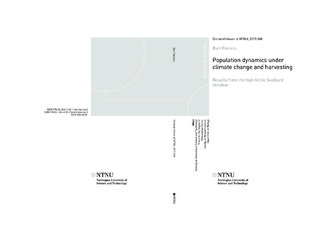| dc.contributor.advisor | Sæther, Bernt-Erik | |
| dc.contributor.advisor | Hansen, Brage Bremset | |
| dc.contributor.advisor | Veiberg, Vebjørn | |
| dc.contributor.author | Peeters, Bart | |
| dc.date.accessioned | 2019-11-06T12:44:37Z | |
| dc.date.available | 2019-11-06T12:44:37Z | |
| dc.date.issued | 2019 | |
| dc.identifier.isbn | 978-82-326-4133-8 | |
| dc.identifier.issn | 1503-8181 | |
| dc.identifier.uri | http://hdl.handle.net/11250/2626926 | |
| dc.description.abstract | To prevent populations or species extinctions due to anthropogenic global change, we need a better mechanistic understanding of the interplay between intrinsic (e.g. resource competition, demographic structure) and extrinsic (e.g. climate change, exploitation) drivers of population dynamics. In this thesis, I demonstrate how interactive effects of climate change and harvesting can shape wildlife population dynamics in time and space. I adopted an interdisciplinary approach combining theoretical and empirical models with time-series data and genetic samples from the high Arctic Svalbard reindeer. I present empirical evidence of the causal links between midwinter rain-on-snow events and basal ice encapsulating the tundra vegetation. These events have become more frequent under recent climate change and can strongly affect resource availability with multiplicative effects on reindeer survival and fecundity at high population densities. Density-dependent effects of rain-on-snow contributed to large-scale spatial synchrony in population fluctuations. However, local populations showed contrasting trends in abundance, which was attributed to spatial heterogeneity in the effects of climate change. This spatial decoupling of population dynamics in the long-run is expected to improve the sub-species’ resilience to climate change. In contrast, analysis of landscape genetics across Svalbard revealed that the rapid loss of sea ice due to climate change leads to increased genetic isolation and, thereby, higher local extinction risk. Moreover, local and regional extinctions due to historical overexploitation and subsequent reintroduction programs modified the observed genetic structure linked to sea ice connectivity and landscape barriers. However, I provide theoretical and empirical-based evidence for a wide range of life histories, with Svalbard reindeer as a case-study, that sustainable harvesting can mitigate over-compensatory responses to weather-induced resource limitation. Thus, harvesting can be used as a management tool to avoid overabundant populations, thereby increasing population stability and resilience to climate change. In conclusion, the results from this thesis demonstrate how anthropogenic stressors can interact to shape population dynamics and genetics in time and space. Accounting for the interplay between different extrinsic and intrinsic drivers could significantly improve the conservation and management of wildlife populations under climate change and harvesting. | nb_NO |
| dc.publisher | NTNU | nb_NO |
| dc.relation.ispartofseries | Doctoral theses at NTNU;2019:268 | |
| dc.relation.haspart | Paper 1: Peeters, Bart; Pedersen, Åshild Ønvik; Loe, Leif Egil; Isaksen, Ketil; Veiberg, Vebjørn; Stien, Audun; Kohler, Jack; Gallet, Jean-Charles; Aanes, Ronny; Hansen, Brage Bremset. Spatiotemporal patterns of rain-on-snow and basal ice in high Arctic Svalbard: detection of a climate-cryosphere regime shift. Environmental Research Letters 2019 ;Volum 14
OA, Original content from this work may be used under the terms of the Creative Commons Attribution 3.0 licence (CC BY 3.0)
https://doi.org/10.1088/1748-9326/aaefb3 | nb_NO |
| dc.relation.haspart | Paper 2:
Hansen, Brage Bremset; Pedersen, Åshild Ønvik; Peeters, Bart; Le Moullec, Mathilde; Albon, Steve D.; Herfindal, Ivar; Sæther, Bernt-Erik; Grøtan, Vidar; Aanes, Ronny.
Spatial heterogeneity in climate change effects decouples the long‐term dynamics of wild reindeer populations in the high Arctic. Global Change Biology 2019
- © 2019 The Authors. Global Change Biology Published by John Wiley & Sons Ltd - This is an open access article under the terms of the Creative Commons Attribution‐NonCommercial License (CC BY-NC 4.0)
https://doi.org/10.1111/gcb.14761| | nb_NO |
| dc.relation.haspart | Paper 3:
Le Moullec M, Raeymaekers JAM, Marquez JF, Røed KH, Pedersen ÅØ,
Veiberg V, Loe LE, Hansen BB.
Sea i 1 ce loss increases genetic isolation in a high Arctic ungulate 2 metapopulation
- This article is awaiting publication and is not included in NTNU Open | nb_NO |
| dc.relation.haspart | Paper 4:
Peeters B, Grøtan V, Gamelon M, Veiberg V, Lee A, Albon S, Fryxell JM, Sæther BE,
Engen S, Loe LE, Hansen BB.
Harvesting can increase population viability by modifying 1 climate change effects
- This article is awaiting publication and is not included in NTNU Open | nb_NO |
| dc.title | Population dynamics under climate change ad harvesting: Results from the high Arctic Svalbard reindeer | nb_NO |
| dc.type | Doctoral thesis | nb_NO |
| dc.subject.nsi | VDP::Mathematics and natural science: 400::Basic biosciences: 470 | nb_NO |

